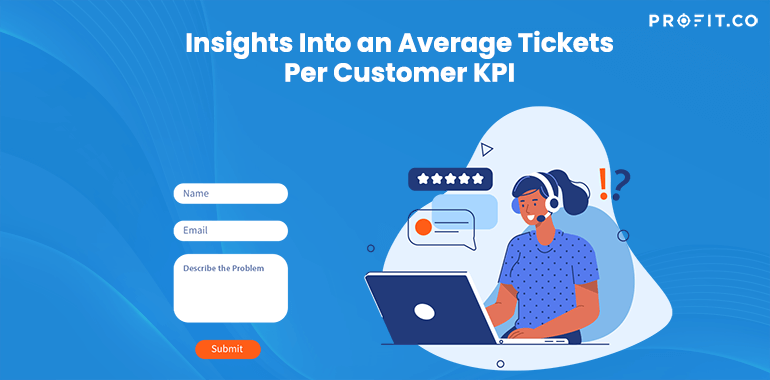Introduction
Understanding customer behavior and preferences is paramount in the ever-evolving world of customer-centric businesses. The average number of tickets per customer is one key metric that can provide valuable insights into customer engagement and satisfaction. According to HubSpot, A Salesforce research states that “If the company’s customer service is excellent, 78% of consumers will do business with a company again after a mistake”. So managing average tickets per customer effectively is very crucial in maintaining customer satisfaction and retaining the image of the customer support is essential while closing every ticket. By unlocking the power of this metric, businesses can gain deeper customer insights and make data-driven decisions to drive growth and enhance the overall customer experience.
What is the Average Ticket Per Customer KPI?
Average Ticket Per Customer KPI is a metric used to measure the average number of support tickets or inquiries each customer generates over a specific period. KPI stands for Key Performance Indicator, which helps you measure and track the progress of your goals. For example, the KPI Average Handle Time (AHT) provides insights into the duration of a customer service interaction. In contrast, Average Ticket Per Customer provides insights into the level of engagement or interaction between customers and the support team.
Formula
The formula for calculating Average Tickets Per Customer is straightforward. It is derived by dividing the total number of tickets by the total number of customers:

This simple formula allows businesses to quantify the average number of tickets generated per customer, providing a quantitative measure of customer engagement.
Example of calculation
Let’s illustrate the calculation with an example. Suppose a company had 500 tickets logged in a given month and 200 unique customers during the same period. The Average number of Tickets Per Customer would be:
Average Tickets Per Customer = 500 / 200 = 2.5
Therefore, on average, each customer generated 2.5 tickets during that month.
What gets measured gets managed.
Leveraging Average Tickets Per Customer with OKRs
One powerful way to leverage Average Tickets Per Customer is by integrating it into your organization’s Objectives and Key Results (OKRs) framework. OKRs provide a strategic context and focus for businesses, and aligning them with Average Tickets Per Customer helps drive improvements and achieve desired outcomes.
Example of OKR
Objective: Enhance Customer Support Experience
Key Result 1: Increase average tickets per customer by 10% through proactive assistance
Initiative: Implement a proactive chat support feature on the company’s website
Key Result 2: Reduce ticket response time by 20% to improve customer satisfaction
Initiative: Streamline ticket management processes with an automated ticket assignment system
Key Result 3: Implement a customer self-service portal to decrease ticket volume by 15%
Initiative: Develop a comprehensive knowledge base and self-help resources on the company’s website
By setting these OKRs, businesses create a roadmap to improve Average Tickets Per Customer, focusing on enhancing customer support, reducing response times, and empowering customers with self-service options.
Ready to start your KPI journey today?
Benefits of Tracking Average Tickets Per Customer as a KPI
Insights into customer behavior
Businesses can gain valuable insights into customer behavior, preferences, and pain points that help tailor products, services, and support to meet customer needs better.
Identifying upselling and cross-selling opportunities
A higher average ticket count per customer may indicate opportunities for upselling or cross-selling additional products or services.
Monitoring customer satisfaction
Average Tickets Per Customer can serve as an indirect measure of customer satisfaction. A decreasing average ticket count may suggest improved customer experience and satisfaction, while an increasing count may indicate potential issues requiring attention. Similarly to how the Average Replies Per Ticket metric helps monitor customer service performance, the Average Tickets Per Customer metric measures customer satisfaction.
Best Practices for Tracking Average Tickets Per Customer
Regular Analysis and Monitoring
Continuously track and analyze the metric over time to identify trends, patterns, and outliers. Regular monitoring allows for timely adjustments and proactive decision-making.
Benchmarking and Comparison
Benchmark your Average Tickets Per Customer against industry standards or competitors to gain insights into your business’s performance relative to others. Identify areas for improvement and set realistic targets for growth.
Integrate Feedback Loops
Establish feedback mechanisms to capture customer feedback directly from support interactions. This qualitative data, combined with the quantitative Average Tickets Per Customer metric, provides a holistic view of the customer experience.
Conclusion
Tracking the “Average Tickets Per Customer,” KPI provides a valuable perspective on customer engagement and support dynamics. This metric enables organizations to gain insights into customer behavior, identify opportunities for improvement, and optimize their support strategies.

